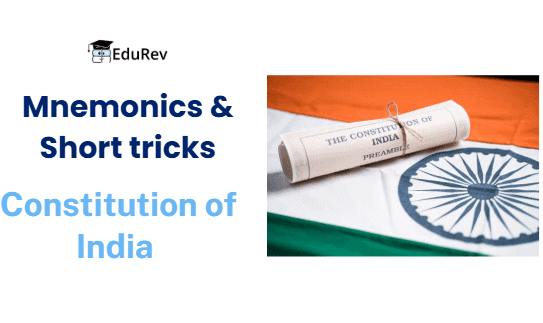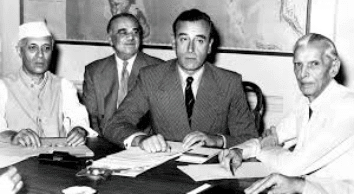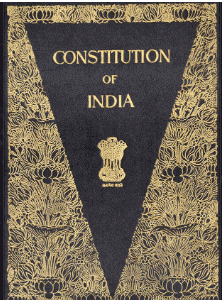Mnemonics: Constitution of India | Indian Polity for UPSC CSE PDF Download
This document will help you understand the key aspects of the Constitution of India that is its historical development ,salient features in a simple and engaging way. Inside, you'll find easy memory tricks (mnemonics) to help you recall important act regarding constitutional development, parts of the Indian Constitution ,etc

Whether you're preparing for the UPSC, SSC CGL, or any other competitive exam, these mnemonics will make studying the Constitution easier and more effective. Use them alongside your regular studies to grasp concepts quickly and retain information for a longer time!
The Constitutional Development
Mnemonic : "RAPID CHANGES MADE GREAT HISTORY"
Each letter represents an important act in constitutional development:
R – Regulating Act (1773) → British Parliament’s first control over East India Company. Warren Hastings became Governor-General.
A – Amending Act (1781) → Supreme Court jurisdiction modified, considered religious customs.
P – Pitt’s India Act (1784) → Divided Company’s commercial and political functions.
I – Indian Councils Acts (1861, 1892) → Introduced representation, discussions in councils.
D – Dual Governance (1919 – Montague-Chelmsford Reforms) → Dyarchy in provinces, bicameralism.
C – Charter Acts (1793, 1813, 1833, 1853) → Ended Company trade monopoly, started civil service exams.
H – Government of India Act (1858) → Replaced Company rule with Crown rule, introduced the Viceroy.
A – Act of 1909 (Minto-Morley Reforms) → Separate electorates for Muslims, direct elections.
N – Government of India Act (1935) → Federal structure, Provincial Autonomy, 3 lists (Federal, Provincial, Concurrent).
G – Indian Independence Act (1947) → India became independent, British control ended.
E – Establishment of Supreme Laws → Led to the framing of the Indian Constitution in 1950.

Parts of the Indian Constitution
From Part I To Part XI
- Part I - Union and its Territory
- Part II - Citizenship.
- Part III - Fundamental Rights.
- Part IV - Directive Principles and Fundamental Duties.
- Part V - The Union.
- Part VI - The States.
- Part VII - States in the B part of the First schedule.
- Part VIII - The Union Territories
- Part IX - Panchayat system and Municipalities.
- Part X - The scheduled and Tribal Areas
- Part XI - Relations between the Union and the States.
Mnemonic:
"Uncle Charlie Fights Daily Until Strong Soldiers Use Power To Rule."
Mnemonic Explanation with Constitution Parts:
Uncle → Union and its Territory (Part I)
Deals with the territory of India, formation of new states, and changes in state boundaries.Charlie → Citizenship (Part II)
Defines the rules for citizenship at the commencement of the Constitution and later laws on acquiring and losing Indian citizenship.Fights → Fundamental Rights (Part III)
Guarantees rights like equality, freedom, protection against exploitation, religious and cultural rights, and constitutional remedies.Daily → Directive Principles and Fundamental Duties (Part IV)
Directive Principles (DPSP) guide the government to establish social and economic democracy, while Fundamental Duties lay down responsibilities for citizens.Until → The Union (Part V)
Covers the structure and functions of the President, Vice-President, Parliament (Lok Sabha & Rajya Sabha), Prime Minister, Attorney General, and other key bodies.Strong → The States (Part VI)
Defines the structure and functioning of state governments, including the Governor, State Legislature, Chief Minister, and Advocate General.Soldiers → States in Part B of First Schedule (Part VII – Now repealed)
Previously dealt with states that were former princely states but was removed by the 7th Amendment in 1956.Use → Union Territories (Part VIII)
Defines the administration of Union Territories, which are directly governed by the Central Government.Power → Panchayati Raj and Municipalities (Part IX)
Introduces a three-tier system of governance (Panchayati Raj) at the village, block, and district levels.To → The Scheduled and Tribal Areas (Part X)
Provides special administration for Scheduled Areas and Tribal Areas to protect the rights and culture of indigenous communities.Rule → Relations between the Union and the States (Part XI)
Defines the distribution of legislative, administrative, and financial powers between the Central and State Governments.
From Part XII To XXII
- Part XII - Finance, Property, Contracts, and Suits
- Part XIII - Trade and Commerce within the territory of India
- Part XIV - Services Under the Union, the States, and Tribunals
- Part XV - Elections
- Part XVI - Special Provisions Relating to certain Classes.
- Part XVII - Languages
- Part XVIII - Emergency Provisions
- Part XIX - Miscellaneous
- Part XX - Amendment of the Constitution
- Part XXI - Temporary, Transitional and Special Provisions
- Part XXII Short title, date of commencement, Authoritative text in Hindi, and Repeals.

Mnemonic:
"Funny Traders Serve Elections, Special Leaders Enjoy Making Amazing Temporary Rules."
Mnemonic Explanation with Constitution Parts:
Funny → Finance, Property, Contracts, and Suits (Part XII)
Deals with financial matters, government property, contracts, and legal suits.Traders → Trade and Commerce within the territory of India (Part XIII)
Ensures free trade and commerce across the country.Serve → Services Under the Union, the States, and Tribunals (Part XIV)
Covers government jobs, recruitment, and tribunals.Elections → Elections (Part XV)
Deals with election procedures and the Election Commission.Special → Special Provisions Relating to Certain Classes (Part XVI)
Provides reservations and protections for SCs, STs, and other weaker sections.Leaders → Languages (Part XVII)
Defines the official languages of the Union and States.Enjoy → Emergency Provisions (Part XVIII)
Covers National, State, and Financial Emergencies.Making → Miscellaneous (Part XIX)
Includes general provisions that don’t fit elsewhere in the Constitution.Amazing → Amendment of the Constitution (Part XX)
Defines the procedure for amending the Constitution.Temporary → Temporary, Transitional, and Special Provisions (Part XXI)
Includes temporary provisions like Article 370 (before abrogation).Rules → Short Title, Date of Commencement, Authoritative Text in Hindi, and Repeals (Part XXII)
Specifies the official name of the Constitution, its commencement date, and repeals old laws
Schedules of Indian Constitution
Mnemonic: "TEARS OF OLD PM"
1. T = Territory (First Schedule)
Subject Dealt: The Union and its Territories
Lists the names and territorial jurisdiction of the States
Lists the names and territorial extent of the Union Territories
Articles Covered: Article 1, Article 4
2. E = Emoluments (Second Schedule)
Subject Dealt: Salaries, allowances, and privileges
- The President of India
- The Governors of States
- Speakers and Deputy Speakers (Lok Sabha and State Assemblies)
- Chairmen and Deputy Chairmen (Rajya Sabha and State Legislative Councils)
- Judges of the Supreme Court and High Courts
- Comptroller and Auditor General of India
Articles Covered: 59, 65, 75, 97, 125, 148, 158, 164, 186, 221
3. A = Affirmations and Oaths (Third Schedule)
Subject Dealt: Forms of Oaths or Affirmations
For Union & State Ministers, MPs, MLAs, Candidates, Judges, and the CAG
Articles Covered: 75, 84, 99, 124, 146, 173, 188, 219
4. R = Rajya Sabha (Fourth Schedule)
Subject Dealt: Allocation of Seats in the Rajya Sabha
Distribution of seats among States and Union Territories
Articles Covered: 4, 80
5. S = Scheduled Areas (Fifth Schedule)
Subject Dealt: Administration and control of Scheduled Areas and Tribes
Articles Covered: 244
6. O = Other Scheduled Areas (Sixth Schedule)
Subject Dealt: Tribal areas in:
- Assam
- Meghalaya
- Tripura
- Mizoram
Articles Covered: 244, 275
7. F = Federal Provisions – 3 Lists (Seventh Schedule)
Subject Dealt: Division of Powers between Union and States
Details:
- List I: Union List
- List II: State List
- List III: Concurrent List
Articles Covered: 246
8. O = Official Languages (Eighth Schedule)
Subject Dealt: Recognized Languages of India
22 languages including Hindi, Tamil, Bengali, Urdu, etc.
Articles Covered: 344, 351
9. L = Land Reforms (Ninth Schedule)
Subject Dealt:
- Laws related to land reforms and abolition of Zamindari
- Laws protected from judicial review
Articles Covered: 31-B
10. D = Defection (Tenth Schedule)
Subject Dealt: Anti-Defection Law
Disqualification of MPs and MLAs on grounds of defection
Articles Covered: 102, 191
11. P = Panchayats (Eleventh Schedule)
Subject Dealt: Powers and responsibilities of Panchayats
29 subjects listed under the 73rd Constitutional Amendment
Articles Covered: 243-G
12. M = Municipalities (Twelfth Schedule)
Subject Dealt: Powers and responsibilities of Municipalities
18 matters listed under the 74th Constitutional Amendment
Articles Covered: 243-W
|
142 videos|777 docs|202 tests
|
FAQs on Mnemonics: Constitution of India - Indian Polity for UPSC CSE
| 1. What are the main parts of the Indian Constitution? |  |
| 2. How many schedules are there in the Indian Constitution? |  |
| 3. What is the significance of the Preamble in the Indian Constitution? |  |
| 4. Can you explain the mnemonic 'RAPID CHANGES MADE GREAT HISTORY' related to the Constitution? |  |
| 5. What are the Fundamental Rights enshrined in the Indian Constitution? |  |





















